Deck 6: Inputs and Production Functions
Question
Question
Question
Question
Question
Question
Question
Question
Question
Question
Question
Question
Question
Question
Question
Question
Question
Question
Question
Question
Question
Question
Question
Question
Question
Question
Question
Question
Question
Question
Question
Question
Question
Question
Question
Question
Question
Question
Question
Question
Question
Question
Question
Question
Question
Question
Question
Question
Question
Question
Question
Question
Question
Question
Question
Question
Question
Question
Question
Question
Question
Question
Question
Question
Question
Question
Question
Question
Question
Question
Question
Question
Question
Question
Question
Question
Question
Question
Question
Question

Unlock Deck
Sign up to unlock the cards in this deck!
Unlock Deck
Unlock Deck
1/108
Play
Full screen (f)
Deck 6: Inputs and Production Functions
1

A)The firm is out of business.
B)The firm is not employing labor and capital efficiently.
C)The production function was not specified correctly.
D)Labor is less productive than capital.
B
2
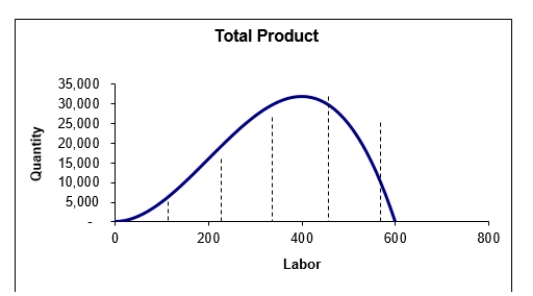
Average product reaches a maximum when labor equals:
A)100
B)200
C)300
D)400
C
3

Given the table above, average productivity is maximized with the ____________ worker.
A)second
B)third
C)fourth
D)sixth
C
4

Given the table above, marginal productivity is maximized with the ___________ worker.
A)second
B)third
C)fourth
D)sixth

Unlock Deck
Unlock for access to all 108 flashcards in this deck.
Unlock Deck
k this deck
5
A labor requirements function represents:
A)the set of feasible levels of labor that will produce a given level of output.
B)the various recipes for producing a given level of output.
C)the minimum amount of labor necessary to produce a given level of output.
D)the set of all feasible combinations of labor and outputs.
A)the set of feasible levels of labor that will produce a given level of output.
B)the various recipes for producing a given level of output.
C)the minimum amount of labor necessary to produce a given level of output.
D)the set of all feasible combinations of labor and outputs.

Unlock Deck
Unlock for access to all 108 flashcards in this deck.
Unlock Deck
k this deck
6
Suppose a production function has only one input, labor. What can you tell about the slope of the production function, assuming output is on the y-axis and labor is on the x-axis, if production exhibits constant marginal returns to labor?
A)The slope of the production function is positive and increasing exponentially.
B)The slope of the production function is a positive constant.
C)The slope of the production function is negative.
D)The slope cannot be determined.
A)The slope of the production function is positive and increasing exponentially.
B)The slope of the production function is a positive constant.
C)The slope of the production function is negative.
D)The slope cannot be determined.

Unlock Deck
Unlock for access to all 108 flashcards in this deck.
Unlock Deck
k this deck
7
The production set represents:
A)the set of all technically feasible combinations of inputs and outputs.
B)the technically efficient combinations of inputs and outputs.
C)the maximum output the firm can produce from a given level of inputs.
D)the minimum amounts of inputs necessary to produce a given level of output.
A)the set of all technically feasible combinations of inputs and outputs.
B)the technically efficient combinations of inputs and outputs.
C)the maximum output the firm can produce from a given level of inputs.
D)the minimum amounts of inputs necessary to produce a given level of output.

Unlock Deck
Unlock for access to all 108 flashcards in this deck.
Unlock Deck
k this deck
8

Given the table above, the marginal productivity of the third worker is:
A)30.
B)40.
C)50.
D)90.

Unlock Deck
Unlock for access to all 108 flashcards in this deck.
Unlock Deck
k this deck
9

Marginal product reaches a maximum when labor equals:
A)100
B)200
C)300
D)400

Unlock Deck
Unlock for access to all 108 flashcards in this deck.
Unlock Deck
k this deck
10
The production function represents:
A)the quantity of inputs necessary to produce a given level of output.
B)the various recipes for producing a given level of output.
C)the minimum amounts of labor and capital needed to produce a given level of output.
D)the set of all feasible combinations of inputs and outputs.
A)the quantity of inputs necessary to produce a given level of output.
B)the various recipes for producing a given level of output.
C)the minimum amounts of labor and capital needed to produce a given level of output.
D)the set of all feasible combinations of inputs and outputs.

Unlock Deck
Unlock for access to all 108 flashcards in this deck.
Unlock Deck
k this deck
11
Which one of these is false when compared to the relationship between marginal and average product? 


Unlock Deck
Unlock for access to all 108 flashcards in this deck.
Unlock Deck
k this deck
12
For a simple graph of a production function with Q on the y-axis and L on the x-axis, which of the following statements is true?
A)The slope of the production function at a specific point equals the marginal product of labor whereas the average slope of the production function equals the average product of labor.
B)The average product of labor is equal to the slope of the ray from the origin to the apex of the production function for all values of L.
C)The slope of the production function at a specific point equals the marginal product of labor whereas the slope between the origin and a specific point on the production function equals the average product of labor.
D)The average product of labor is never equal to the slope of the ray from the origin to the apex of the production function.
A)The slope of the production function at a specific point equals the marginal product of labor whereas the average slope of the production function equals the average product of labor.
B)The average product of labor is equal to the slope of the ray from the origin to the apex of the production function for all values of L.
C)The slope of the production function at a specific point equals the marginal product of labor whereas the slope between the origin and a specific point on the production function equals the average product of labor.
D)The average product of labor is never equal to the slope of the ray from the origin to the apex of the production function.

Unlock Deck
Unlock for access to all 108 flashcards in this deck.
Unlock Deck
k this deck
13
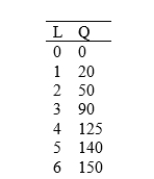
Given the table above, the average productivity of the fifth worker is:
A)20.
B)28.
C)30.
D)140.

Unlock Deck
Unlock for access to all 108 flashcards in this deck.
Unlock Deck
k this deck
14
If marginal product is greater than average product:
A)total product must be increasing.
B)marginal product must be decreasing.
C)marginal product must be increasing.
D)average product may be increasing or decreasing.
A)total product must be increasing.
B)marginal product must be decreasing.
C)marginal product must be increasing.
D)average product may be increasing or decreasing.

Unlock Deck
Unlock for access to all 108 flashcards in this deck.
Unlock Deck
k this deck
15
Factors of production are:
A)inputs and outputs.
B)outputs only
C)inputs only
D)the minimum set of inputs that can produce a certain fixed quantity of output.
A)inputs and outputs.
B)outputs only
C)inputs only
D)the minimum set of inputs that can produce a certain fixed quantity of output.

Unlock Deck
Unlock for access to all 108 flashcards in this deck.
Unlock Deck
k this deck
16
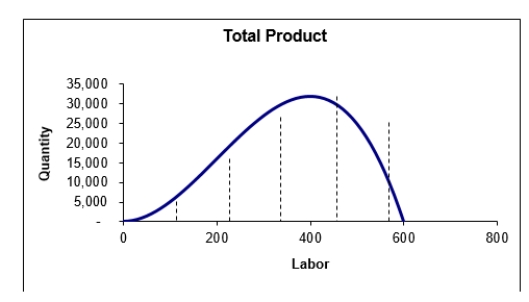
*Diminishing marginal returns set in at labor equals:
A)100
B)200
C)300
D)400

Unlock Deck
Unlock for access to all 108 flashcards in this deck.
Unlock Deck
k this deck
17
When labor is the only input to the production function, why must it be true that when the marginal product of labor is greater than the average product of labor, the average product of labor is increasing and vice versa?
A)When the marginal product of labor is above the average product of labor, an additional unit of labor will produce a greater marginal product than average, thus raising the average.
B)When the marginal product of labor is below the average product of labor, an additional unit of labor will produce a greater marginal product than average, thus raising the average.
C)When the marginal product of labor is above the average product of labor, an additional unit of labor will produce a smaller marginal product than average, thus reducing the average.
D)When the marginal product of labor is above the average product of labor, an additional unit of labor will produce a zero marginal product.
A)When the marginal product of labor is above the average product of labor, an additional unit of labor will produce a greater marginal product than average, thus raising the average.
B)When the marginal product of labor is below the average product of labor, an additional unit of labor will produce a greater marginal product than average, thus raising the average.
C)When the marginal product of labor is above the average product of labor, an additional unit of labor will produce a smaller marginal product than average, thus reducing the average.
D)When the marginal product of labor is above the average product of labor, an additional unit of labor will produce a zero marginal product.

Unlock Deck
Unlock for access to all 108 flashcards in this deck.
Unlock Deck
k this deck
18

When labor equals 100:
A)average product is less than marginal product
B)average product is greater than marginal product.
C)average product is equal to marginal product.
D)the relationship between average product and marginal product cannot be determined from a total product graph.

Unlock Deck
Unlock for access to all 108 flashcards in this deck.
Unlock Deck
k this deck
19
The labor requirements function is derived from:
A)the demand curve.
B)the supply curve.
C)the production function.
D)the capital requirement function.
A)the demand curve.
B)the supply curve.
C)the production function.
D)the capital requirement function.

Unlock Deck
Unlock for access to all 108 flashcards in this deck.
Unlock Deck
k this deck
20
Technically inefficient points are:
A)points in the production set but not on the production function.
B)points on the production function.
C)points contained in neither the production set nor the production function.
D)points that are never observed in practice.
A)points in the production set but not on the production function.
B)points on the production function.
C)points contained in neither the production set nor the production function.
D)points that are never observed in practice.

Unlock Deck
Unlock for access to all 108 flashcards in this deck.
Unlock Deck
k this deck
21
Diminishing marginal returns occur when the total product function is:
A)decreasing.
B)increasing at a decreasing rate.
C)increasing at a constant rate.
D)increasing at an increasing rate.
A)decreasing.
B)increasing at a decreasing rate.
C)increasing at a constant rate.
D)increasing at an increasing rate.

Unlock Deck
Unlock for access to all 108 flashcards in this deck.
Unlock Deck
k this deck
22
The expression given below explains: 
A)Product hill
B)Marginal product of labor
C)Non-marginal product
D)Total product

A)Product hill
B)Marginal product of labor
C)Non-marginal product
D)Total product

Unlock Deck
Unlock for access to all 108 flashcards in this deck.
Unlock Deck
k this deck
23
Total product hill is:
A)A single line graph that shows the relationship between the quantity of output and the quantity of one of two inputs employed by the firm
B)A two-dimensional graph that shows the relationship between the quantity of output and the quantity of one of two inputs employed by the firm
C)A three-dimensional graph that shows the relationship between the quantity of output and the quantity of the two inputs employed by the firm
D)A four-dimensional graph that shows the relationship between the quantity of output and the quantity of the two inputs employed by the firm
A)A single line graph that shows the relationship between the quantity of output and the quantity of one of two inputs employed by the firm
B)A two-dimensional graph that shows the relationship between the quantity of output and the quantity of one of two inputs employed by the firm
C)A three-dimensional graph that shows the relationship between the quantity of output and the quantity of the two inputs employed by the firm
D)A four-dimensional graph that shows the relationship between the quantity of output and the quantity of the two inputs employed by the firm

Unlock Deck
Unlock for access to all 108 flashcards in this deck.
Unlock Deck
k this deck
24
The law of diminishing marginal returns states that:
A)when the marginal product is above the average product, average product must be increasing.
B)when the marginal product is below the average product, average product must be decreasing.
C)as the use of one input increases holding the quantities of the other inputs fixed, the marginal product of the input eventually declines.
D)as the use of all inputs increases, the marginal product of the inputs eventually declines.
A)when the marginal product is above the average product, average product must be increasing.
B)when the marginal product is below the average product, average product must be decreasing.
C)as the use of one input increases holding the quantities of the other inputs fixed, the marginal product of the input eventually declines.
D)as the use of all inputs increases, the marginal product of the inputs eventually declines.

Unlock Deck
Unlock for access to all 108 flashcards in this deck.
Unlock Deck
k this deck
25
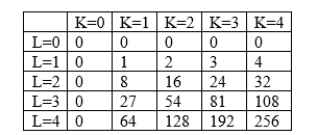
Based on the table above, holding labor constant at 2 units, the average productivity of three units of capital is
A)8.
B)12.
C)21.
D)24.

Unlock Deck
Unlock for access to all 108 flashcards in this deck.
Unlock Deck
k this deck
26
When isoquants are convex to the origin,:
A)the marginal rate of technical substitution is inverted.
B)the marginal rate of technical substitution is decreasing.
C)the marginal rate of technical substitution is constant.
D)the marginal rate of technical substitution is increasing.
A)the marginal rate of technical substitution is inverted.
B)the marginal rate of technical substitution is decreasing.
C)the marginal rate of technical substitution is constant.
D)the marginal rate of technical substitution is increasing.

Unlock Deck
Unlock for access to all 108 flashcards in this deck.
Unlock Deck
k this deck
27
Suppose the production function can be expressed as  Which of the following combinations of capital and labor lie on the same isoquant?
Which of the following combinations of capital and labor lie on the same isoquant?
A)(5, 6)and (4, 5)
B)(3, 2)and (7, 1)
C)(4, 3)and (2, 6)
D)(10, 3)and (15, 4)
 Which of the following combinations of capital and labor lie on the same isoquant?
Which of the following combinations of capital and labor lie on the same isoquant?A)(5, 6)and (4, 5)
B)(3, 2)and (7, 1)
C)(4, 3)and (2, 6)
D)(10, 3)and (15, 4)

Unlock Deck
Unlock for access to all 108 flashcards in this deck.
Unlock Deck
k this deck
28
An isoquant represents:
A)all combinations of inputs that produce a given level of output at the same cost.
B)all combinations of inputs that produce a given level of output.
C)all combinations of output that require the same levels of inputs.
D)all combinations of inputs that cost the same amount.
A)all combinations of inputs that produce a given level of output at the same cost.
B)all combinations of inputs that produce a given level of output.
C)all combinations of output that require the same levels of inputs.
D)all combinations of inputs that cost the same amount.

Unlock Deck
Unlock for access to all 108 flashcards in this deck.
Unlock Deck
k this deck
29
When a production function can be expressed as  ,the relationship between capital and labor in the production function is that:
,the relationship between capital and labor in the production function is that:
A)capital and labor are perfect substitutes, and the isoquants are linear.
B)capital and labor must be combined in fixed proportions, and the isoquants are L-shaped.
C)capital and labor are easily substituted, and the isoquants are convex to the origin.
D)capital and labor are perfect substitutes, and the isoquants are L-shaped.
 ,the relationship between capital and labor in the production function is that:
,the relationship between capital and labor in the production function is that:A)capital and labor are perfect substitutes, and the isoquants are linear.
B)capital and labor must be combined in fixed proportions, and the isoquants are L-shaped.
C)capital and labor are easily substituted, and the isoquants are convex to the origin.
D)capital and labor are perfect substitutes, and the isoquants are L-shaped.

Unlock Deck
Unlock for access to all 108 flashcards in this deck.
Unlock Deck
k this deck
30
When a production function can be expressed as  the relationship between capital and labor in the production function is that:
the relationship between capital and labor in the production function is that:
A)capital and labor are perfect substitutes, and the isoquants are linear.
B)capital and labor must be combined in fixed proportions, and the isoquants are L-shaped.
C)capital and labor are substitutable, and the isoquants are convex to the origin.
D)capital and labor are perfect substitutes, and the isoquants are L-shaped.
 the relationship between capital and labor in the production function is that:
the relationship between capital and labor in the production function is that:A)capital and labor are perfect substitutes, and the isoquants are linear.
B)capital and labor must be combined in fixed proportions, and the isoquants are L-shaped.
C)capital and labor are substitutable, and the isoquants are convex to the origin.
D)capital and labor are perfect substitutes, and the isoquants are L-shaped.

Unlock Deck
Unlock for access to all 108 flashcards in this deck.
Unlock Deck
k this deck
31


Unlock Deck
Unlock for access to all 108 flashcards in this deck.
Unlock Deck
k this deck
32
The rate at which one input can be exchanged for another input without altering the level of output is called the:
A)marginal product curve.
B)average product curve.
C)marginal rate of technical substitution.
D)law of diminishing marginal productivity.
A)marginal product curve.
B)average product curve.
C)marginal rate of technical substitution.
D)law of diminishing marginal productivity.

Unlock Deck
Unlock for access to all 108 flashcards in this deck.
Unlock Deck
k this deck
33
A measure of how quickly the marginal rate of technical substitution of labor for capital changes as we move along an isoquant is the:
A)capital-labor ratio
B)elasticity of substitution
C)input substitution possibility frontier
D)rate of technological progress
A)capital-labor ratio
B)elasticity of substitution
C)input substitution possibility frontier
D)rate of technological progress

Unlock Deck
Unlock for access to all 108 flashcards in this deck.
Unlock Deck
k this deck
34
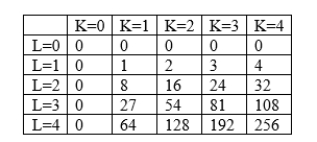
Based on the table above, holding capital constant at 3 units, the marginal productivity of the second laborer is
A)8.
B)12.
C)21.
D)24.

Unlock Deck
Unlock for access to all 108 flashcards in this deck.
Unlock Deck
k this deck
35

A)5
B)25
C)50
D)1

Unlock Deck
Unlock for access to all 108 flashcards in this deck.
Unlock Deck
k this deck
36
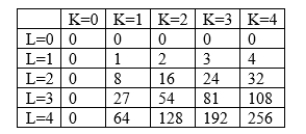
Based on the table above, holding labor constant, what do you notice about the marginal productivity of capital?
A)The marginal productivity of capital is always increasing.
B)The marginal productivity of capital is always constant.
C)The marginal productivity of capital is always decreasing.
D)The marginal productivity of capital increases, then decreases.

Unlock Deck
Unlock for access to all 108 flashcards in this deck.
Unlock Deck
k this deck
37
The slope of the isoquant can be expressed as:
A)the ratio of the input prices.
B)the ratio of the inputs.
C)the ratio of the marginal productivities of the inputs.
D)the sum of the marginal productivities of the inputs.
A)the ratio of the input prices.
B)the ratio of the inputs.
C)the ratio of the marginal productivities of the inputs.
D)the sum of the marginal productivities of the inputs.

Unlock Deck
Unlock for access to all 108 flashcards in this deck.
Unlock Deck
k this deck
38
The marginal rate of technical substitution of labor for capital is defined as:
A)The rate at which the quantity of capital can be decreased for every one unit increase in the quantity of labor, holding the quantity of output constant
B)The rate at which the quantity of capital must be increased for every one unit decrease in the quantity of labor, holding the cost of output constant.
C)The rate at which the cost of labor and capital increases as output rises.
D)The rate at which output rises as capital increases, holding labor constant.
A)The rate at which the quantity of capital can be decreased for every one unit increase in the quantity of labor, holding the quantity of output constant
B)The rate at which the quantity of capital must be increased for every one unit decrease in the quantity of labor, holding the cost of output constant.
C)The rate at which the cost of labor and capital increases as output rises.
D)The rate at which output rises as capital increases, holding labor constant.

Unlock Deck
Unlock for access to all 108 flashcards in this deck.
Unlock Deck
k this deck
39

A)The average product of labor is 2 and the marginal product of labor is 2.
B)The average product of labor is 1 and the marginal product of labor is 3.
C)The average product of labor is 3 and the marginal product of labor is 2.
D)The average product of labor is 2 and the marginal product of labor is 3.

Unlock Deck
Unlock for access to all 108 flashcards in this deck.
Unlock Deck
k this deck
40
Increasing marginal returns occur when the total product function is:
A)decreasing.
B)increasing at a decreasing rate.
C)increasing at a constant rate.
D)Increasing at an increasing rate.
A)decreasing.
B)increasing at a decreasing rate.
C)increasing at a constant rate.
D)Increasing at an increasing rate.

Unlock Deck
Unlock for access to all 108 flashcards in this deck.
Unlock Deck
k this deck
41

A)isoquant function
B)Cobb-Douglas production function
C)fixed-proportions function
D)perfect complements function

Unlock Deck
Unlock for access to all 108 flashcards in this deck.
Unlock Deck
k this deck
42
The region of upward sloping backward bending isoquants is:
A)Economic region of production
B)Uneconomic region of production
C)Marginal rate of production
D)Marginal rate of technical substitution
A)Economic region of production
B)Uneconomic region of production
C)Marginal rate of production
D)Marginal rate of technical substitution

Unlock Deck
Unlock for access to all 108 flashcards in this deck.
Unlock Deck
k this deck
43

A)0.3
B)1.5
C)0.67
D)3.00

Unlock Deck
Unlock for access to all 108 flashcards in this deck.
Unlock Deck
k this deck
44
A type of production function that includes linear production functions, fixed-proportions production functions, and Cobb-Douglas production functions as special cases is:
A)Cobb-Douglas production function
B)Constant elasticity of substitution (CES)production function
C)Fixed proportions production functions
D)Linear production functions
A)Cobb-Douglas production function
B)Constant elasticity of substitution (CES)production function
C)Fixed proportions production functions
D)Linear production functions

Unlock Deck
Unlock for access to all 108 flashcards in this deck.
Unlock Deck
k this deck
45
A fixed proportions production function:
A)is not observed in practice.
B)has straight line isoquants.
C)has L-shaped isoquants.
D)has a constant marginal rate of technical substitution as the firm substitutes labor for capital.
A)is not observed in practice.
B)has straight line isoquants.
C)has L-shaped isoquants.
D)has a constant marginal rate of technical substitution as the firm substitutes labor for capital.

Unlock Deck
Unlock for access to all 108 flashcards in this deck.
Unlock Deck
k this deck
46
If capital cannot easily be substituted for labor, then the elasticity of substitution is:
A)negative.
B)close to zero.
C)close to one.
D)approaching infinity.
A)negative.
B)close to zero.
C)close to one.
D)approaching infinity.

Unlock Deck
Unlock for access to all 108 flashcards in this deck.
Unlock Deck
k this deck
47
When a production function has the form  , we can say that:
, we can say that:
A)the production function is linear and the inputs are perfect substitutes.
B)the production function is linear and the inputs are perfect complements.
C)the production function is linear and the inputs are used in fixed factor proportions only.
D)the production function is non-linear and the inputs are perfect substitutes.
 , we can say that:
, we can say that:A)the production function is linear and the inputs are perfect substitutes.
B)the production function is linear and the inputs are perfect complements.
C)the production function is linear and the inputs are used in fixed factor proportions only.
D)the production function is non-linear and the inputs are perfect substitutes.

Unlock Deck
Unlock for access to all 108 flashcards in this deck.
Unlock Deck
k this deck
48
The marginal rate of technical substitution in production is analogous to the marginal rate of substitution for the consumer's optimization problem in that
A)the slope of the consumer's indifference curve is the opposite of the ratios of the marginal utilities of the two goods, whereas the slope of the production isoquant is the opposite of the ratio of the marginal product of labor relative to the marginal product of capital.
B)the slope of the consumer's indifference curve is equal to the ratio of the marginal utilities of the two goods, whereas the slope of the production isoquant is the opposite of the ratio of the marginal product of labor relative to the marginal product of capital.
C)the slope is equal in both instances.
D)they are calculated by subtracting the price ratio from the output level.
A)the slope of the consumer's indifference curve is the opposite of the ratios of the marginal utilities of the two goods, whereas the slope of the production isoquant is the opposite of the ratio of the marginal product of labor relative to the marginal product of capital.
B)the slope of the consumer's indifference curve is equal to the ratio of the marginal utilities of the two goods, whereas the slope of the production isoquant is the opposite of the ratio of the marginal product of labor relative to the marginal product of capital.
C)the slope is equal in both instances.
D)they are calculated by subtracting the price ratio from the output level.

Unlock Deck
Unlock for access to all 108 flashcards in this deck.
Unlock Deck
k this deck
49


Unlock Deck
Unlock for access to all 108 flashcards in this deck.
Unlock Deck
k this deck
50
The production function  exhibits:
exhibits:
A)increasing returns to scale.
B)constant returns to scale.
C)decreasing returns to scale.
D)undefined returns to scale.
 exhibits:
exhibits:A)increasing returns to scale.
B)constant returns to scale.
C)decreasing returns to scale.
D)undefined returns to scale.

Unlock Deck
Unlock for access to all 108 flashcards in this deck.
Unlock Deck
k this deck
51

A)decreasing returns to scale.
B)constant returns to scale.
C)increasing returns to scale.
D)either decreasing or constant returns to scale, but more information is needed to determine which one.

Unlock Deck
Unlock for access to all 108 flashcards in this deck.
Unlock Deck
k this deck
52

A)decreasing returns to scale.
B)constant returns to scale.
C)increasing returns to scale.
D)either decreasing or constant returns to scale, but more information is needed to determine which one.

Unlock Deck
Unlock for access to all 108 flashcards in this deck.
Unlock Deck
k this deck
53


Unlock Deck
Unlock for access to all 108 flashcards in this deck.
Unlock Deck
k this deck
54

A)2.00
B)1.50
C)1.00
D)0.50

Unlock Deck
Unlock for access to all 108 flashcards in this deck.
Unlock Deck
k this deck
55

A)declines as the firm substitutes labor for capital.
B)remains constant as the firm substitutes labor for capital.
C)implies upward-sloping, straight-line isoquants.
D)is undefined.

Unlock Deck
Unlock for access to all 108 flashcards in this deck.
Unlock Deck
k this deck
56
Returns to scale refers to:
A)the increase in output that accompanies an increase in one input, all other inputs held constant.
B)a change in a production process that enables a firm to achieve more output from a given combination of inputs.
C)the number of units of increase in output that can be obtained from an increase in one unit of input.
D)the percentage by which output will increase when all inputs are increased by a given percentage.
A)the increase in output that accompanies an increase in one input, all other inputs held constant.
B)a change in a production process that enables a firm to achieve more output from a given combination of inputs.
C)the number of units of increase in output that can be obtained from an increase in one unit of input.
D)the percentage by which output will increase when all inputs are increased by a given percentage.

Unlock Deck
Unlock for access to all 108 flashcards in this deck.
Unlock Deck
k this deck
57


Unlock Deck
Unlock for access to all 108 flashcards in this deck.
Unlock Deck
k this deck
58
Suppose every molecule of salt requires exactly one sodium atom, Na, and one chlorine atom, Cl. The production function that describes this is: 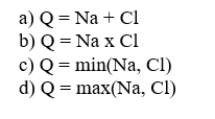


Unlock Deck
Unlock for access to all 108 flashcards in this deck.
Unlock Deck
k this deck
59
Assuming a firm uses capital and labor to produce output, which of the following is not always a true statement?
A)Assuming the marginal products of labor and capital are greater than zero, doubling the inputs of capital and labor will lead to greater output.
B)Assuming the marginal products of labor and capital are less than zero, doubling the inputs of capital and labor will lead to less output.
C)Assuming the marginal products of labor and capital are greater than zero, doubling the inputs of capital and labor will lead to double the output.
D)Assuming the marginal products of labor and capital are greater than zero, doubling the input of capital and keeping the input of labor constant will lead to greater output.
A)Assuming the marginal products of labor and capital are greater than zero, doubling the inputs of capital and labor will lead to greater output.
B)Assuming the marginal products of labor and capital are less than zero, doubling the inputs of capital and labor will lead to less output.
C)Assuming the marginal products of labor and capital are greater than zero, doubling the inputs of capital and labor will lead to double the output.
D)Assuming the marginal products of labor and capital are greater than zero, doubling the input of capital and keeping the input of labor constant will lead to greater output.

Unlock Deck
Unlock for access to all 108 flashcards in this deck.
Unlock Deck
k this deck
60
Which of the following is true? 


Unlock Deck
Unlock for access to all 108 flashcards in this deck.
Unlock Deck
k this deck
61
For a simple graph of a production function with Q on the y-axis and L on the x-axis, the slope of the production function at a specific point equals the marginal product of labor whereas the average slope of the production function equals the average product of labor.

Unlock Deck
Unlock for access to all 108 flashcards in this deck.
Unlock Deck
k this deck
62

A)Neutral technological progress has occurred.
B)Labor-saving technological progress has occurred.
C)Capital-saving technological progress has occurred.
D)Economies of scale have increased.

Unlock Deck
Unlock for access to all 108 flashcards in this deck.
Unlock Deck
k this deck
63
Technically inefficient points only exist with older firms.

Unlock Deck
Unlock for access to all 108 flashcards in this deck.
Unlock Deck
k this deck
64
Identify the true statement.
A)Decreasing returns to scale and diminishing marginal returns are just two different ways of saying the same thing.
B)Returns to scale pertains to the impact on output of increasing all inputs simultaneously; diminishing marginal returns pertains to the impact of changing a single input while holding all other inputs constant.
C)Returns to scale pertains to the impact on output of changing a single input while holding all other inputs constant; diminishing marginal returns pertains to the impact on output of increasing all inputs simultaneously.
D)Returns to scale can be identified by calculating the slope of an isoquant.
A)Decreasing returns to scale and diminishing marginal returns are just two different ways of saying the same thing.
B)Returns to scale pertains to the impact on output of increasing all inputs simultaneously; diminishing marginal returns pertains to the impact of changing a single input while holding all other inputs constant.
C)Returns to scale pertains to the impact on output of changing a single input while holding all other inputs constant; diminishing marginal returns pertains to the impact on output of increasing all inputs simultaneously.
D)Returns to scale can be identified by calculating the slope of an isoquant.

Unlock Deck
Unlock for access to all 108 flashcards in this deck.
Unlock Deck
k this deck
65
When the marginal product curve lies above the average product curve, then average product is rising.

Unlock Deck
Unlock for access to all 108 flashcards in this deck.
Unlock Deck
k this deck
66
A production manager notices that when she triples all of her inputs simultaneously, her output doubles. The production manager determines that for this range of output, the production function exhibits:
A)increasing returns to scale.
B)constant returns to scale.
C)decreasing returns to scale.
D)undefined returns to scale.
A)increasing returns to scale.
B)constant returns to scale.
C)decreasing returns to scale.
D)undefined returns to scale.

Unlock Deck
Unlock for access to all 108 flashcards in this deck.
Unlock Deck
k this deck
67
Technically inefficient points are points on the production function.

Unlock Deck
Unlock for access to all 108 flashcards in this deck.
Unlock Deck
k this deck
68
Because the production function identifies the maximum amount of output that can be produced from a given combination of inputs, only technically efficient input combinations are found on the production function.

Unlock Deck
Unlock for access to all 108 flashcards in this deck.
Unlock Deck
k this deck
69
For a simple graph of a production function with Q on the y-axis and L on the x-axis, the average product of labor is equal to the slope of the ray from the origin to the apex of the production function for all values of L.

Unlock Deck
Unlock for access to all 108 flashcards in this deck.
Unlock Deck
k this deck
70
For a simple graph of a production function with Q on the y-axis and L on the x-axis, the average product of labor is never equal to the slope of the ray from the origin to the apex of the production function.

Unlock Deck
Unlock for access to all 108 flashcards in this deck.
Unlock Deck
k this deck
71
Suppose over time that a firm's production process undergoes capital-saving technological progress. This implies:
A)the isoquants corresponding to any particular level of output will shift outward from the origin and the along any ray from the origin will increase.
B)the isoquants corresponding to any particular level of output will shift outward from the origin and the along any ray from the origin will decrease.
C)the isoquants corresponding to any particular level of output will shift inward toward the origin and the along any ray from the origin will increase.
D)the isoquants corresponding to any particular level of output will shift inward toward the origin and the along any ray from the origin will decrease.
A)the isoquants corresponding to any particular level of output will shift outward from the origin and the along any ray from the origin will increase.
B)the isoquants corresponding to any particular level of output will shift outward from the origin and the along any ray from the origin will decrease.
C)the isoquants corresponding to any particular level of output will shift inward toward the origin and the along any ray from the origin will increase.
D)the isoquants corresponding to any particular level of output will shift inward toward the origin and the along any ray from the origin will decrease.

Unlock Deck
Unlock for access to all 108 flashcards in this deck.
Unlock Deck
k this deck
72
For a simple graph of a production function with Q on the y-axis and L on the x-axis, the slope of the production function at a specific point equals the marginal product of labor whereas the slope between the origin and a specific point on the production function equals the average product of labor.

Unlock Deck
Unlock for access to all 108 flashcards in this deck.
Unlock Deck
k this deck
73
Given a production function  ,we can say that:
,we can say that:
A)this production function is not Cobb-Douglas.
B)this production function is Cobb-Douglas and exhibits decreasing returns to scale.
C)this Cobb-Douglas production function does not exhibit a constant elasticity of substitution.
D)this production function is Cobb-Douglas and exhibits increasing returns to scale.
 ,we can say that:
,we can say that:A)this production function is not Cobb-Douglas.
B)this production function is Cobb-Douglas and exhibits decreasing returns to scale.
C)this Cobb-Douglas production function does not exhibit a constant elasticity of substitution.
D)this production function is Cobb-Douglas and exhibits increasing returns to scale.

Unlock Deck
Unlock for access to all 108 flashcards in this deck.
Unlock Deck
k this deck
74

A)decreasing returns to scale.
B)constant returns to scale.
C)increasing returns to scale.
D)either decreasing or constant returns to scale, but more information is needed to determine which one.

Unlock Deck
Unlock for access to all 108 flashcards in this deck.
Unlock Deck
k this deck
75
When the marginal product of labor is falling, the average product of labor is falling.

Unlock Deck
Unlock for access to all 108 flashcards in this deck.
Unlock Deck
k this deck
76
Technically inefficient points are points that are never observed in practice.

Unlock Deck
Unlock for access to all 108 flashcards in this deck.
Unlock Deck
k this deck
77
Technically inefficient points are points contained in neither the production set nor the production function.

Unlock Deck
Unlock for access to all 108 flashcards in this deck.
Unlock Deck
k this deck
78
The production function identifies the technically feasible combinations of inputs.

Unlock Deck
Unlock for access to all 108 flashcards in this deck.
Unlock Deck
k this deck
79
Assume that labor is measured along the horizontal axis and capital is measured along the vertical axis. If the decreases as we move inward toward the origin along the ray (slope of the isoquant becomes flatter), we are observing:
A)neutral technological progress.
B)labor-saving technological progress.
C)capital-saving technological progress.
D)both labor-saving and capital-saving technological progress.
A)neutral technological progress.
B)labor-saving technological progress.
C)capital-saving technological progress.
D)both labor-saving and capital-saving technological progress.

Unlock Deck
Unlock for access to all 108 flashcards in this deck.
Unlock Deck
k this deck
80
Technically inefficient points are points in the production set but not on the production function.

Unlock Deck
Unlock for access to all 108 flashcards in this deck.
Unlock Deck
k this deck



